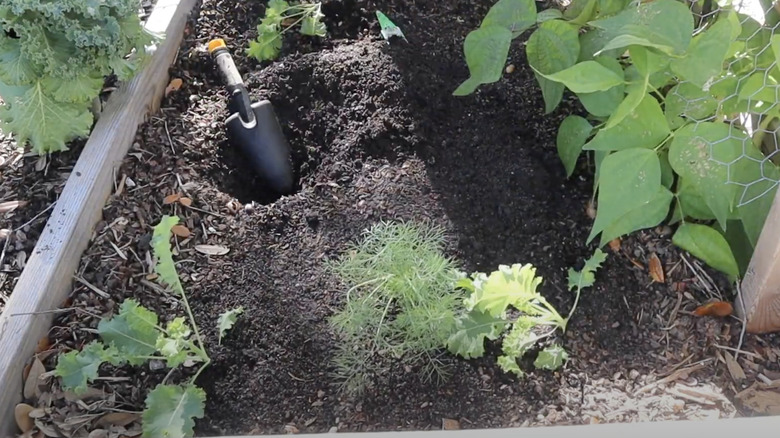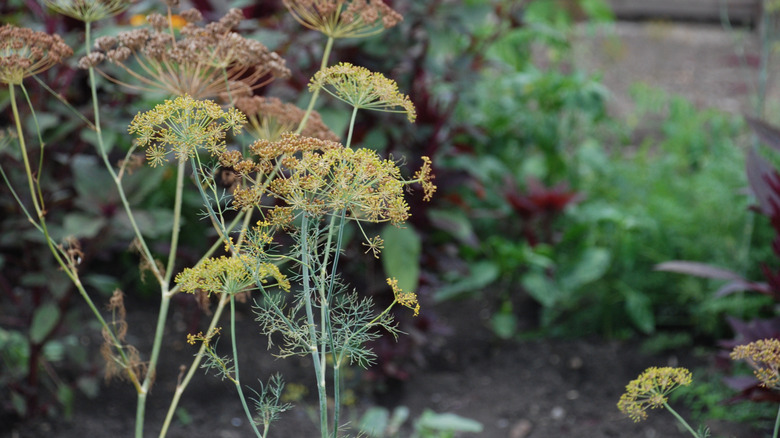Stop Heat From Ruining Your Dill With A Simple Plant Pairing
We may receive a commission on purchases made from links.
Companion planting benefits your garden by preventing pests, controlling weeds, and, if done carefully, regulating shade and soil temperatures, extending the growing season of temperature-sensitive plants. So it goes with troublesome dill (Anethum graveolens). Unlike us humans, who have swimming pools and air conditioning to cool down with, dill hates the summer heat. It will protest by halting its leaf production — the part we culinary herb gardeners care about — and sending up a tall, umbrella-like flower head. The answer? Grow dill with, or more aptly, underneath, kale. The towering vegetable will shade your dill plants during the hottest part of the day and year, effectively tricking dill into thinking it's cooler than it actually is. And that may delay bolting — for a while at least.
Bolting, also sometimes called going to seed, is when a plant transitions to its final stage of growth for the season. That means putting out flowers, getting them pollinated, and producing seeds. At the same time, a plant's leaf production typically slows as it puts all its energy into blooming. Lots of common garden plants bolt, from popular vegetables like broccoli, collards, and lettuce to herbs like the cilantro and basil, but they do so at different temperatures. Some plants handle the heat while others prefer cooler climes. Dill will, for example, start to bolt at temperatures over 85 degrees Fahrenheit, though the exact benchmark varies depending on the cultivar. While dill leaves are still edible after the plant bolts, the flavor dulls considerably — not a great outcome if you're growing it for culinary use.
Planting kale with dill extends the herb's harvest
Dill and kale are both cool season crops, best planted in early spring. However, dill seeds take anywhere around 10 days to germinate, and the plants reach a harvestable size in about six weeks. Compare that to kale's two to three weeks to germination and as many as 60 days to maturity, depending on the cultivar. Dill, with its diaphanous stems and leaves, is unlikely to crowd out bulky kale; you can tuck dill seedlings neatly between kale plants without causing stress to either species.
This means your sun-loving dill plants get lots of light while the kale plants are young. Then, as the growing season progresses through spring into the summer, the kale plants reach heady heights of 36 inches. Their broad leaves shade the feathery dill plants from the harsh summer sun, stalling the bolt and extending the harvest window, even if just for a little while longer. Indeed, while dill is widely promoted as a full sun plant, it not only appreciates but may even thrive in dappled shade, particularly in the high heat of a summer afternoon. This is especially true for gardeners growing dill in the southern U.S.
Shade isn't the only reason to plant kale and dill together. Kale has a shallow root system and needs regular, deep watering. Incidentally, consistently damp soil keeps dill from bolting as the temperatures climb. What's more, lanky dill can easily blow over on windy days. If you live in a tempestuous area, use sturdy kale as a windbreak in addition to staking your dill plants.
How to plant dill and kale together (and how to embrace inevitable bolting)
To make the dill-kale partnership work best, choose the right varieties of dill. For example, the cultivar 'Fernleaf' is classified as a warm season annual and, as such, it doesn't bolt as readily as others. Get a 4-pack of Bonnie Plants 18 to 24 Inch Tall 'Fernleaf' Dill Plants for about $28. It's also a dwarf plant, reaching heights of just 18 to 24 inches, meaning you can maximize the shade provided by the towering kale. If you prefer to plant a cool season dill, go for 'Bouquet'. A packet of over 1,000 HOME GROWN Non-GMO USA Heirloom 'Bouquet' Dill Seeds costs about $6.
Embrace succession planting to make the most of your garden space and sow dill seeds every two weeks throughout the growing season. A word of warning: Don't overcrowd the kale. Dill plants will grow leggy with few harvestable leaves and weak stems in deep shade. Also, no matter how large and shade-providing the kale is, your dill plants will bolt eventually. Don't panic! Here's what to do if your herb garden starts flowering ... Save the seeds that follow the blooms and get free plants for next season. You dill plants will also self-seed readily if left to their own devices.


